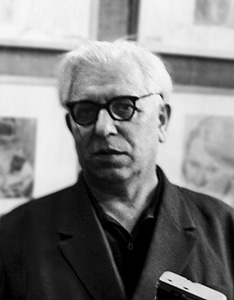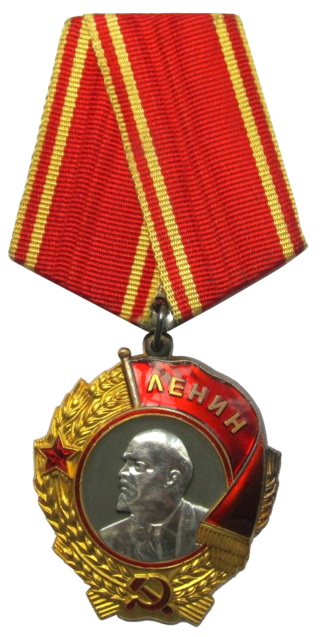This article needs additional citations for verification .(April 2019) |
| |||||
| Decades: | |||||
|---|---|---|---|---|---|
| See also: | |||||
The following lists events that happened during 1938 in the Union of Soviet Socialist Republics .
This article needs additional citations for verification .(April 2019) |
| |||||
| Decades: | |||||
|---|---|---|---|---|---|
| See also: | |||||
The following lists events that happened during 1938 in the Union of Soviet Socialist Republics .

Nikolai Ivanovich Bukharin was a Russian revolutionary, Soviet politician, and Marxist theorist. A prominent Bolshevik described by Vladimir Lenin as a "most valuable and major theorist" of the Communist Party, Bukharin was active in the Soviet leadership from 1917 to his purge in the 1930s.

Novodevichy Cemetery is a cemetery in Moscow. It lies next to the southern wall of the 16th-century Novodevichy Convent, which is the city's third most popular tourist site.

Mikhail Petrovich Frinovsky was a Soviet secret police official who served as a deputy head of the NKVD under Nikolai Yezhov during the Great Purge.

Union of Artists of Saint Petersburg was established on August 2, 1932, as a creative union of the Leningrad artists and arts critics. Prior to 1959, it was called "Leningrad Union of Soviet Artists". From 1959, it was called as Leningrad branch of Union of Artists of Russian Federation. After the renaming of the city in 1991, it became known as the Saint Petersburg Union of Artists.

Vladimir Alexandrovich Gorb was a Soviet Russian painter, graphic artist, and art teacher. He lived and worked in Leningrad as professor of the Repin Institute of Arts, was awarded the title of Honored Art Worker of Russian Federation, and was member of the Leningrad branch of Union of Artists of Russian Federation. He is regarded as a representative of the Leningrad school of painting, most famous for his portrait paintings and Art teaching.

Komkor is the abbreviation for corps commander, and was a military rank in the Soviet Armed Forces of the USSR in the period from 1935 to 1940. It was also the designation for officers appointed to command a corps sized formation.

Valery Ivanovich Mezhlauk (1893–1938) was a government and party official in the Soviet Union during the decades of the 1920s and 1930s. He is best remembered as the Chairman of the State Planning Committee (Gosplan) from 1934 to 1937. He became a victim of Stalin’s Great Purge and was executed on July 29, 1938. He was posthumously rehabilitated in 1956.

Alexei Ivanovich Rykov was a Russian Bolshevik revolutionary and a Soviet politician and statesman, most prominent as premier of Russia and the Soviet Union from 1924 to 1929 and 1924 to 1930 respectively. He was one of the accused in Joseph Stalin's show trials during the Great Purge.
The Case of the Anti-Soviet "Bloc of Rightists and Trotskyites", also known as the Trial of the Twenty-One, was the last of the three public Moscow trials charging prominent Bolsheviks with espionage and treason. The Trial of the Twenty-One took place in Moscow in March 1938, towards the end of the Soviet Great Purge. The accused were tortured to extract confessions and publicly admitted their guilt during the show trial. Most of the accused, including Nikolai Bukharin, Alexei Rykov and Genrikh Yagoda, were convicted to death. All charges are considered fabricated except that Valerian Kuybyshev, Vyacheslav Menzhinsky, and Maxim Gorky might indeed be poisoned by NKVD chief Genrikh Yagoda with the assistance of "Kremlin's doctors" Pletnyov and Lev Levin, but they did it on the orders from Stalin himself.
The following lists events that happened during 1937 in the Union of Soviet Socialist Republics.

The Kommunarka firing range, former dacha of secret police chief Genrikh Yagoda, was used as a burial ground from 1937 to 1941. Executions may have been carried out there by the NKVD during the Great Terror and until the war started; alternatively, bodies of those shot elsewhere might have been brought there for later interment. As Russian historian Arseny Roginsky explained: "firing range" was a popular euphemism adopted to describe mysterious and closely-guarded plots of land that the NKVD began to set aside for mass burials on the eve of the Great Terror.

The Order of Lenin was an award named after Vladimir Lenin, the leader of the October Revolution. It was established by the Central Executive Committee on 6 April 1930. The order was the highest civilian decoration bestowed by the Soviet Union. The order was awarded to:

The State Duma of the Federal Assembly of the Russian Federation of the 5th convocation is a former convocation of the legislative branch of the State Duma, lower house of the Russian Parliament. The 5th convocation met at the State Duma building in Moscow, worked from December 24, 2007 to December 21, 2011.
The Stalinist execution list of July 26, 1938 was signed during the Great Purge of the Soviet Union by Joseph Stalin and Vyacheslav Molotov.

An index of articles related to the Russian Revolution and the Russian Civil War period (1905–1922). It covers articles on topics, events, and persons related to the revolutionary era, from the 1905 Russian Revolution until the end of the Russian Civil War. The See also section includes other lists related to Revolutionary Russia and the Soviet Union, including an index of articles about the Soviet Union (1922–1991) which is the next article in this series, and Bibliography of the Russian Revolution and Civil War.
Stalin's purges and massacres between 1936 and the invasion of the Soviet Union by Nazi Germany had about one million victims. This list includes some of the most prominent victims along with the date of their deaths. Except where otherwise stated, the date is that on which the individual was executed by shooting.
Individuals and events related to 1921 in the Civil War-era Russia.